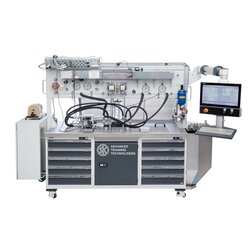Pneumatic Training Systems & Equipment
Sort by
Learn more about Pneumatics Training Equipment
In this section you will learn more about Pneumatics Training Equipment and Systems, and the easiest way to acquire some for your training center.
What is Pneumatics?
Pneumatics refers to the concept of putting gases (such as air or other gases) under pressure to transfer power from one place to another.
This is done through a compressor which through pipes and tubing powers cylinders, air motors and pneumatic actuators, and other pneumatic applications.
The benefit of using pneumatics instead of hydraulics is that it is often cheaper, more reliable, more chock absorbent and safer. The drawback with pneumatics is that it cannot transfer as much power as hydraulics and that its less precise (air and gases can be compressed, as opposed to liquids).
Pneumatics is used in many diverse applications, such as dentistry, automotive air brakes, material handling, packaging, industrial robotics, construction etc.
Pneumatics Training Equipment
Pneumatic training equipment is a didactic system of instructional technology, including hardware and software components, alongside educational content.
There are various producers of pneumatics training equipment and they all have their own instructive approach to the learning process.
Pneumatics Training Equipment
Pneumatic training equipment is a didactic system of instructional technology, including hardware and software components, alongside educational content.
There are various producers of pneumatics training equipment and they all have their own instructive approach to the learning process.


